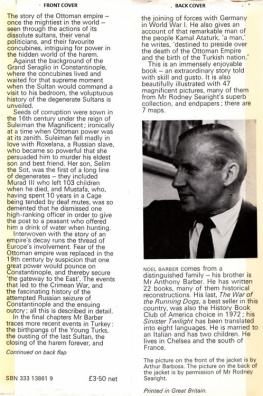Thomas - The Golden Empire
Here you can read online Thomas - The Golden Empire full text of the book (entire story) in english for free. Download pdf and epub, get meaning, cover and reviews about this ebook. year: 2011, publisher: Random House Publishing Group, genre: Art. Description of the work, (preface) as well as reviews are available. Best literature library LitArk.com created for fans of good reading and offers a wide selection of genres:
Romance novel
Science fiction
Adventure
Detective
Science
History
Home and family
Prose
Art
Politics
Computer
Non-fiction
Religion
Business
Children
Humor
Choose a favorite category and find really read worthwhile books. Enjoy immersion in the world of imagination, feel the emotions of the characters or learn something new for yourself, make an fascinating discovery.

The Golden Empire: summary, description and annotation
We offer to read an annotation, description, summary or preface (depends on what the author of the book "The Golden Empire" wrote himself). If you haven't found the necessary information about the book — write in the comments, we will try to find it.
Thomas: author's other books
Who wrote The Golden Empire? Find out the surname, the name of the author of the book and a list of all author's works by series.
The Golden Empire — read online for free the complete book (whole text) full work
Below is the text of the book, divided by pages. System saving the place of the last page read, allows you to conveniently read the book "The Golden Empire" online for free, without having to search again every time where you left off. Put a bookmark, and you can go to the page where you finished reading at any time.
Font size:
Interval:
Bookmark:




Copyright 2010 by Hugh Thomas
All rights reserved.
Published in the United States by Random House, an imprint of The Random House Publishing Group, a division of Random House, Inc., New York.
Random House and colophon are registered trademarks of Random House, Inc.
Originally published in 2010 in the United Kingdom by Allen Lane, an imprint of Penguin Books, as The Golden Age: The Spanish Empire of Charles V.
Library of Congress Cataloging-in-Publication Data
Thomas, Hugh.
The golden empire : Spain, Charles V, and the creation of America / Hugh Thomas.
p. cm.
Includes bibliographical references.
eISBN: 978-1-58836-904-8
1. Latin AmericaHistory16th century. 2. Latin AmericaDiscovery and explorationSpanish. 3. Latin AmericaCivilizationSpanish influences. 4. SpainHistoryCharles I, 15161556. 5. Charles V, Holy Roman Emperor, 15001558. 6. SpainColoniesAmericaAdministrationHistory16th century. I. Title.
F1411.T46 2011
980.01dc22 2010035313
www.atrandom.com
v3.1
To Vanessa
A constant inspiration
This book, though I hope it will be seen as complete in itself, is the second in a series of volumes I am writing about the Spanish empire. The first volume was Rivers of Gold, published in 2003. I am now at work on a third volume, which takes the extraordinary story to 1580, when Spain ceased to expand her responsibilities. King Philip II decided in that year not to try to conquer China.
I have several acknowledgments: first to Stuart Proffitt and his colleagues at Penguin in London. Stuart showed himself a publisher from whose friendship I gained as much as I did from his expertise and judgment. Also I am grateful to David Ebershoff and his staff at Random House in New York. They were patient, meticulous, and a pleasure to work with. Dana Isaacson of Random House made many helpful suggestions. I am grateful, too, for his work on the text, to Martin Davies, an excellent and learned editor. I am also thankful to Ana Bustelo of Planeta for much help, especially collecting the illustrations, and I am also most grateful to the Museo de Santa Cruz in Toledo. My editorial thanks also go to my agent, my imaginative friend Andrew Wylie, and his remarkable assistants. Teresa Velasco typed and retyped the manuscript with care and accuracy. I owe her and Cecilia Calamante a great deal for their hard work on my behalf.
To sum up ones indebtedness to other writers is difficult. But I should be singularly ungrateful were I not to put on record how much I owe to Manuel Fernndez lvarez, whose work on the sixteenth century is an example to us all; and to the conquest of Perus great historian John Hemming, whose research and writings have placed all students of the matter under a lasting obligation. He also corrected the proofs and saved me from many mistakes. The extent of my debt to the writings of this close friend of mine is by no means covered by the references in the text. My wife, Vanessa, also read the proofs with attention. I am also grateful to James Lockhart for his remarkable study The Men of Cajamarca (Austin, Tex., 1972), and his earlier work Spanish Peru (Madison, Wisc., 1968). Like everyone who has worked on Peru in the sixteenth century, I have been much assisted by the work of the late Guillermo Lohmann, whom I used to see at eight oclock in the morning on the steps of the Archivo de Indias waiting for entrance to the saln de lectores in the old building of Herrera in Seville. He was always at his table before me. Other works that were of great value to me included Marcel Bataillons Erasme et lEspagne and Jos Martnez Millns La corte de Carlos V. Sir John Elliott kindly corrected some howlers.
Like others who have written of the conquest of Peru, I have depended greatly on the numerous contemporary accounts which I have been able to study, such as those written by Garcilaso de la Vega, Pedro de Cieza de Len, Hernando Pizarro, Francisco de Jerez, Pedro Sancho de Hoz, Fray Toms de Berlanga, Alonso Enrquez de Guzmn, Miguel de Estete, Gonzalo Fernndez de Oviedo, Cristbal de Mena, and Agustn de Zrate. But I have missed the great number of informaciones de servicios y mritos that characterized the contemporary history of New Spain/Mexico.
Carlos I and Carlos V are rendered Charles as a matter of course.
In Rivers of Gold, I elected to speak of Ferdinand, king of Aragon, as Fernando. I do the same here. But once the infante Fernando, Charles Vs brother, becomes established in Austria, I call him (the archduke) Ferdinand.
Moctezuma is rendered Montezuma, the English translation of the name. I have found it so spelled by Spaniards several times in the sixteenth century.
On the other hand, I have rendered the Aztecs by their more accurate designation, Mexica. I have normally rendered the capital, Mexico City, by the Spanish usage, Mexico.
The usual item of currency was the maraved, a piece of copper worth 1/96 of a gold mark, which in its turn was equivalent to 230,045 grams. A ducado (ducat) was worth 375 maraveds, 1 real was 34 maraveds, 1 peso was 450 maraveds, and 1 castellano was equivalent to 485 maraveds. A cruzado was an old coin, sometimes gold, sometimes silver, and occasionally copper, each of different value. An escudo was worth 40 reales, and a cuento had an indeterminate value.
H UGH T HOMAS , M AY 5, 2010
Click on the illustration numbers below to navigate to each illustration. You can then click the illustration number beneath the image to navigate back to this section.
Charles V as a young man (Fitzwilliam Museum, Cambridge)
Mercurino Gattinara (Museo Arqueolgico Nacional, Madrid)
Gonzalo Prez (Museo Arqueolgico Nacional, Madrid)
Francisco de los Cobos (Fundacin Casa Ducal de Medinaceli, Seville)
Granvelle (Kunsthistorisches Museum, Vienna)
The empress Isabel of Portugal (Museo del Prado)
The archduchess Margaret of Austria (Monastre royal de Brou, Bourg-en-Bresse)
Pope Clement VII (Musei Vaticani, Rome)
Pope Paul III, Alessandro Farnese (Museo di Capodimonte, Naples)
Bishop Quiroga (Cathedral, Morelia, Michoacan, Mexico, photograph by Vicente Guijosa, published in La Utopia Mexicana del siglo XVI, lo bello, lo verdadero y lo bueno, Presentacin de Octavio Paz, edited by Grupo Izbiche [1992], p. 73)
Archbishop Juan de Zumrraga (Museo Nacional del Virreinato, Tepotzotln, Mexico, photograph by Rafael Doniz, published in La Utopia, as above, p. 45)
Antonio de Mendoza (Museo Nacional de Historia, Mexico, photograph by Javier Hinojosa, published in La Utopia, as above, p. 21)
A Spanish galleon (Stdelsches Kunstinstitut, Frankfurt)
Spanish lombard of the fifteenth to sixteenth century (Museo del Ejrcito, Madrid, now Toledo)
Bartolom de las Casas (Fundacin Jos Manuel Lara, Seville)
Portable altar (Museo de la Catedral, Burgos)
Font size:
Interval:
Bookmark:
Similar books «The Golden Empire»
Look at similar books to The Golden Empire. We have selected literature similar in name and meaning in the hope of providing readers with more options to find new, interesting, not yet read works.
Discussion, reviews of the book The Golden Empire and just readers' own opinions. Leave your comments, write what you think about the work, its meaning or the main characters. Specify what exactly you liked and what you didn't like, and why you think so.












